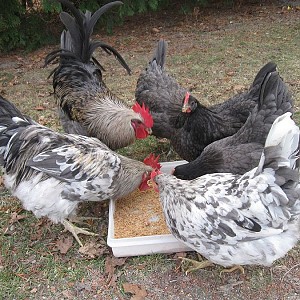thanks for taking the time to document
Navigation
Install the app
How to install the app on iOS
Follow along with the video below to see how to install our site as a web app on your home screen.
Note: This feature may not be available in some browsers.
More options
You are using an out of date browser. It may not display this or other websites correctly.
You should upgrade or use an alternative browser.
You should upgrade or use an alternative browser.
Blue Isbar
- Added by gootziecat
- Create date
- Updated
Blue Isbars are a breed developed in the 50-60’s by a monk by the name of Martin Silverudd. He...
- NHMountainMan
- 5.00 star(s)
- Beachy_Hen
- 5.00 star(s)
Pros: Sweetest and most beautiful Roo I’ve ever had, beautiful birds, unique eggs
- Purchase Date
- 3/1/2019
- Purpletie3
- 5.00 star(s)
Pros: smart, great flyers, lay in the cold, beautiful colors
We love the blue isbars in our flock. They are beautiful birds with beautiful eggs. My blue isbar roosters gave their lives by distracting a threat away from the flock. My blue hen would roost 14' in my maple tree until she finally settled down with the hona & black isbar flock. I would have 100 blue's in my flock if I could!
- Purchase Price
- 29.00
- Purchase Date
- 2015-01-26
- Tammylr
- 5.00 star(s)
Pros: Great layer of gorgeous eggs.
Cons: None
I would love to add this auto sexing bred to my back yard!

- gootziecat
- 4.00 star(s)
Pros: Friendly, pretty, great layer, not a huge bird, forages, green eggs
Cons: genetic issues surface
Blue Isbars are a breed developed in the 50-60’s by a monk by the name of Martin Silverudd. He wasn’t able to complete auto sexing of this color, as planned, before he died. But even without the auto sexing, this breed developed into a good and beautiful layer. Greenfire Farm imported them in 2011 from Sweden.
Greenfire Farms first imports were reported to have immune issues, so a second group of blue Isbars was import to rectify the problem. It seems to have been quite helpful in enlarging the small gene pool. Breeders are working to keep the breed hardy and at this point, the problem is diminishing. This has been a set back to the breed, but breeders are finding Isbars are worth the effort.
Blue Isbars are a beautiful, large fowl, created by crossing Rhode Island Reds, New Hampshires, and cream Legbars. They are in the range of 5-7 pounds and come in black, blue and splash. The roosters often have a beautiful iridescent “leakage” of color in their hackles, bows, and saddle. Hens can lay upward of 200 green eggs yearly. They are the only known breed that has a single comb and lays a green egg. The color can vary from a light green to a darker, mossy, and sometimes almost a coppery green. They can darken as the hen ages as well as vary in shade from one day to the next. Some eggs even have speckles. They are medium to large in size. Hens can go broody but not exceedingly so that it’s annoying. They do well in both cold and hot weather, generally laying through all seasons, and some times through molt.
The chicks are usually quite friendly, although some report they can be skittish. Adults are calm and friendly to be around. The birds love to forage right from the start and are thrifty, easy keepers. Some breeders are proclaiming this is their favorite breed of all the breeds they raise. Indeed, they are deserving of such praise.
Pictures courtesy of J-Bar Farms.
Greenfire Farms first imports were reported to have immune issues, so a second group of blue Isbars was import to rectify the problem. It seems to have been quite helpful in enlarging the small gene pool. Breeders are working to keep the breed hardy and at this point, the problem is diminishing. This has been a set back to the breed, but breeders are finding Isbars are worth the effort.
Blue Isbars are a beautiful, large fowl, created by crossing Rhode Island Reds, New Hampshires, and cream Legbars. They are in the range of 5-7 pounds and come in black, blue and splash. The roosters often have a beautiful iridescent “leakage” of color in their hackles, bows, and saddle. Hens can lay upward of 200 green eggs yearly. They are the only known breed that has a single comb and lays a green egg. The color can vary from a light green to a darker, mossy, and sometimes almost a coppery green. They can darken as the hen ages as well as vary in shade from one day to the next. Some eggs even have speckles. They are medium to large in size. Hens can go broody but not exceedingly so that it’s annoying. They do well in both cold and hot weather, generally laying through all seasons, and some times through molt.
The chicks are usually quite friendly, although some report they can be skittish. Adults are calm and friendly to be around. The birds love to forage right from the start and are thrifty, easy keepers. Some breeders are proclaiming this is their favorite breed of all the breeds they raise. Indeed, they are deserving of such praise.
Pictures courtesy of J-Bar Farms.
×






